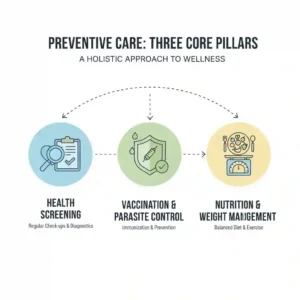Introduction: A Paradigm Shift from Treatment to Prevention
The field of companion animal health has undergone a profound transformation. The primary goal is no longer merely to treat illness but to actively preserve health and extend the quality of life. This proactive approach, known as preventive medicine, is the cornerstone of modern veterinary practice. It represents a collaborative partnership between pet owners and veterinary professionals, grounded in scientific evidence and tailored to the individual animal’s life stage, breed, and lifestyle.
The First Pillar: Lifelong Health Surveillance and Screening
The most powerful tool in our arsenal is the detection of subclinical disease—ailments that are present but not yet showing overt symptoms. Regular health assessments are crucial for establishing a baseline and identifying subtle deviations.
-
The Semi-Annual Wellness Examination: For senior pets (typically over seven years of age), biannual check-ups are recommended. These consultations allow for the monitoring of weight, dental health, musculoskeletal condition, and behaviour, enabling the early detection of common age-related issues such as chronic kidney disease, osteoarthritis, and endocrine disorders.
-
Diagnostic Baseline Testing: An annual blood panel and urinalysis provide an invaluable internal snapshot of your pet’s health. These tests assess organ function, detect metabolic imbalances, and can reveal the earliest signs of systemic disease, often long before any outward signs are apparent.
The Second Pillar: Core Vaccination and Robust Parasite Control
The principle of “protection, not reaction” is paramount in managing infectious and parasitic diseases. Protocols should be individually designed based on a risk assessment conducted by your veterinary surgeon.
-
Vaccination: Core vaccinations in the UK protect against diseases with significant morbidity and mortality, such as Canine Parvovirus and Canine Distemper in dogs, and Feline Panleukopenia and Cat ‘Flu in cats. The current scientific consensus, supported by the World Small Animal Veterinary Association (WSAVA), advocates for a move away from annual re-vaccination by default, towards a more nuanced approach involving triennial core vaccines and titre testing where appropriate.
-
Parasite Prevention: A year-round, comprehensive parasite control programme is non-negotiable. It must address both internal and external parasites, many of which are also zoonotic. The climate in the UK supports flea populations year-round in domestic environments, and ticks, which can transmit Lyme disease and other infections, are increasingly prevalent. Regular, veterinary-prescribed preventative treatments are the most effective strategy.

The Third Pillar: The Interconnected Triad of Nutrition, Weight, and Dental Health
These three elements are deeply intertwined, each profoundly influencing the others and the pet’s overall systemic health.
-
Optimal Body Condition: Obesity is a disease, not a cosmetic issue. It is a primary inflammatory condition that predisposes pets to a host of secondary problems, including diabetes mellitus, cardiovascular stress, and exacerbated osteoarthritis. Maintaining a lean body condition score is one of the single most impactful actions an owner can take to extend their pet’s healthspan.
-
Oral Health as a Window to Systemic Health: Periodontal disease is exceedingly common, affecting over 80% of dogs and cats over the age of three. The chronic inflammation and bacteraemia associated with dental infection have been scientifically linked to pathology in distant organs, including the kidneys, liver, and heart. Professional dental prophylaxis and daily home care are essential components of preventive care.
Conclusion: An Investment in a Shared Future
Embracing a philosophy of preventive veterinary medicine is an investment in your pet’s long-term vitality and your shared quality of life. It is a commitment to using the best available evidence to make informed decisions that forestall disease, rather than merely managing its consequences. By partnering with your veterinary practice to implement these foundational pillars, you are championing a future defined not by illness, but by sustained health and well-being.
(Academic Reference)
Bellows, J., Colitz, C. M., Daristotle, L., Ingram, D. K., Lepine, A., Marks, S. L., … & Zhang, J. (2015). Defining healthy aging in older dogs and differentiating healthy aging from disease. Journal of the American Veterinary Medical Association, 246(1), 77-89.



